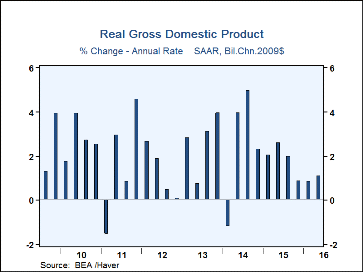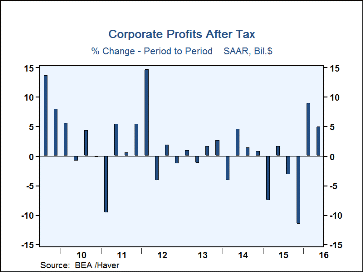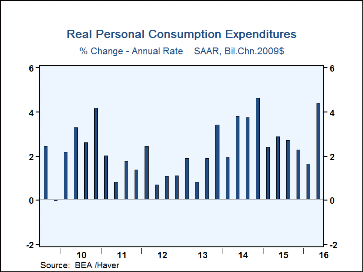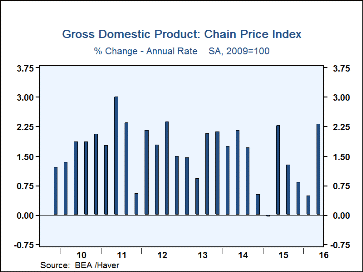 Global| Aug 26 2016
Global| Aug 26 2016U.S. GDP Growth Lessened While Corporate Profits Increase
by:Tom Moeller
|in:Economy in Brief
Summary
Economic growth during Q2'16 was revised lower to 1.1% (SAAR, 1.2% y/y) from the initial estimate of a 1.2% gain. The revision was accompanied by the first report of corporate earnings, which showed a 4.9% rise (-2.2% y/y), the second [...]
Economic growth during Q2'16 was revised lower to 1.1% (SAAR, 1.2% y/y) from the initial estimate of a 1.2% gain. The revision was accompanied by the first report of corporate earnings, which showed a 4.9% rise (-2.2% y/y), the second consecutive quarter of firm increase. The GDP revision was as expected in the Action Economic Forecast Survey.
Despite the downward revision to overall economic growth, the increase in consumer spending was revised higher to 4.4% (2.7% y/y). It was the strongest increase since Q4'14. Durable goods purchases advanced at a 9.9% rate (4.8% y/y), fueled by a 15.2% strengthening (9.6% y/y) of recreational goods & vehicles purchases. Home furnishings & appliance buying rose 10.2% (7.3% y/y) while motor vehicle purchases grew 8.0% (-0.0% y/y). Nondurable goods spending gained 5.7% (3.0% y/y) as food & beverage purchases rose 7.5% (2.4% y/y), and apparel spending gained 4.9% (1.7% y/y). Gasoline spending eased 0.7% (+2.5% y/y). In the services sector, spending increased 3.1% (2.3% y/y) as housing & utilities outlays rose 4.2% (1.2% y/y). Health care outlays firmed 3.9% (4.2% y/y) but recreation outlays declined 3.5% (1.5% y/y).
Business fixed investment eased at a lessened 0.9% rate (-1.0% y/y), the least of three sequential quarterly declines. Structures outlays declined 8.4% (-7.1% y/y); they've been falling since Q4'14. Equipment outlays declined 3.7% (-1.9% y/y) as information processing equipment fell 4.8% (+4.2% y/y), but industrial equipment outlays grew 9.1% (2.4% y/y). Spending on transportation equipment declined 7.8% (-3.3% y/y). Intellectual property product spending gained 8.6% (4.7% y/y) due to a 14.4% strengthening (11.8% y/y) of software outlays. Research & development investment rose 17.1% (7.1% y/y).
Residential investment fell at a 7.7% rate (+5.7% y/y), the first decline since Q1'14.
Government purchases declined at a 1.5% annual rate (+0.7% y/y) as state & local buying fell 2.2% (+0.8% y/y). Federal government purchases eased 0.3% (+0.7% y/y) as defense spending dropped 3.1% (-0.8% y/y), about the same as in Q1.
Inventory investment subtracted a slightly increased 1.3 percentage points from economic growth. It was the largest of five consecutive quarterly reductions. The foreign trade sector added a slightly lessened 0.1 percentage point to overall economic growth. Exports grew 1.2% (-1.3% y/y) while imports improved 0.3% (0.4% y/y).
After tax corporate profits without IVA & CCA increased 4.9%, but still declined 2.2% y/y. Profits before tax with IVA & CCA declined 1.2% (-4.9% y/y). Domestic nonfinancial industry profits declined 7.7% y/y while domestic financial industry profits dropped 20.0% y/y. Profits earned abroad improved 3.6% y/y.
The GDP price index increased at a 2.3% rate (1.2% y/y), which was revised up minimally. The personal consumption price index increased 2.0% (1.0% y/y), and excluding food & beverages, it rose 1.8% (1.6% y/y). The nonresidential investment price index increased 1.2% (0.5% y/y), while the residential investment price index jumped 5.8% (3.2% y/y). The government sector price index increased 2.7% (0.7% y/y).
The GDP figures can be found in Haver's USECON and USNA database. USNA contains virtually all of the Bureau of Economic Analysis' detail in the national accounts, including the integrated economic accounts and the recently added GDP data for U.S. Territories. The Action Economics consensus estimates can be found in AS1REPNA.
The Federal Reserve's Monetary Policy Toolkit: Past, Present, and Future is the title of today's speech by Fed Chair Janet L. Yellen, and it can be found here.
| Chained 2009 $ (%, AR) | Q2'16 (2nd Estimate) | Q2'16 (Advance Estimate) | Q1'16 | Q4'15 | Q2'16 Y/Y | 2015 | 2014 | 2013 |
|---|---|---|---|---|---|---|---|---|
| Gross Domestic Product | 1.1 | 1.2 | 0.8 | 0.9 | 1.2 | 2.6 | 2.4 | 1.7 |
| Inventory Effect | -1.3 | -1.2 | -0.4 | -0.4 | -0.7 | 0.2 | 0.0 | 0.2 |
| Final Sales | 2.4 | 2.4 | 1.3 | 1.2 | 1.9 | 2.4 | 2.5 | 1.5 |
| Foreign Trade Effect | 0.1 | 0.2 | 0.0 | -0.5 | -0.1 | -0.7 | -0.1 | 0.3 |
| Domestic Final Sales | 2.2 | 2.1 | 1.2 | 1.7 | 2.0 | 3.1 | 2.6 | 1.2 |
| Demand Components | ||||||||
| Personal Consumption Expenditures | 4.4 | 4.2 | 1.6 | 2.3 | 2.7 | 3.2 | 2.9 | 1.5 |
| Business Fixed Investment | -0.9 | -2.2 | -3.4 | -3.3 | -1.0 | 2.1 | 6.0 | 3.5 |
| Residential Investment | -7.7 | -6.1 | 7.8 | 11.5 | 5.7 | 11.7 | 3.5 | 11.9 |
| Government Spending | -1.5 | -0.9 | 1.6 | 0.1 | 0.7 | 1.8 | -0.9 | -2.9 |
| Chain-Type Price Index | ||||||||
| GDP | 2.3 | 2.2 | 0.5 | 0.8 | 1.2 | 1.1 | 1.8 | 1.6 |
| Personal Consumption Expenditures | 2.0 | 1.9 | 0.3 | 0.4 | 1.0 | 0.3 | 1.5 | 1.3 |
| Less Food/Energy | 1.8 | 1.7 | 2.1 | 1.2 | 1.6 | 1.4 | 1.6 | 1.5 |
Tom Moeller
AuthorMore in Author Profile »Prior to joining Haver Analytics in 2000, Mr. Moeller worked as the Economist at Chancellor Capital Management from 1985 to 1999. There, he developed comprehensive economic forecasts and interpreted economic data for equity and fixed income portfolio managers. Also at Chancellor, Mr. Moeller worked as an equity analyst and was responsible for researching and rating companies in the economically sensitive automobile and housing industries for investment in Chancellor’s equity portfolio. Prior to joining Chancellor, Mr. Moeller was an Economist at Citibank from 1979 to 1984. He also analyzed pricing behavior in the metals industry for the Council on Wage and Price Stability in Washington, D.C. In 1999, Mr. Moeller received the award for most accurate forecast from the Forecasters' Club of New York. From 1990 to 1992 he was President of the New York Association for Business Economists. Mr. Moeller earned an M.B.A. in Finance from Fordham University, where he graduated in 1987. He holds a Bachelor of Arts in Economics from George Washington University.












